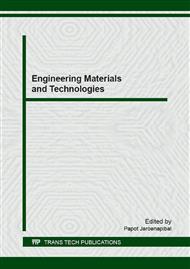p.26
p.30
p.36
p.40
p.45
p.51
p.57
p.62
p.67
Concentration and Temperature Dependences of Effective Ethanol Vapor Permeance of Plastic Films Utilized in Controlled Release-Based Active Packaging for Horticultural Products
Abstract:
In the present work effective film permeances to ethanol vapor (FPE) of Low Density Polyethylene (LDPE) and Nylon/PE films were determined in relations to ethanol vapor concentrations and storage temperatures (10°C and 25°C). The FPE was characterized using the isostatic and the gravimetric methods. The values of FPE show dependences on both storage temperatures and ethanol vapor concentration (0.25-3.17 mol⋅m-3). Experimental data on FPE were well predicted with the exponential growth model with Root Mean Square Error (RMSE) value in a range of 0.0002-0.005. At comparable ethanol vapor concentration, research findings show that (i) average permeances of LDPE were higher than those of Nylon/PE, and, (2) the effective permeances measured at 10°C, for each films, were higher than those measured at 25°C, except the permeance of LDPE film measured at 10°C using 0.6-0.7 mol⋅m-3 was lower than that measured at 25°C.
Info:
Periodical:
Pages:
45-48
Citation:
Online since:
November 2016
Keywords:
Price:
Сopyright:
© 2017 Trans Tech Publications Ltd. All Rights Reserved
Share:
Citation:


